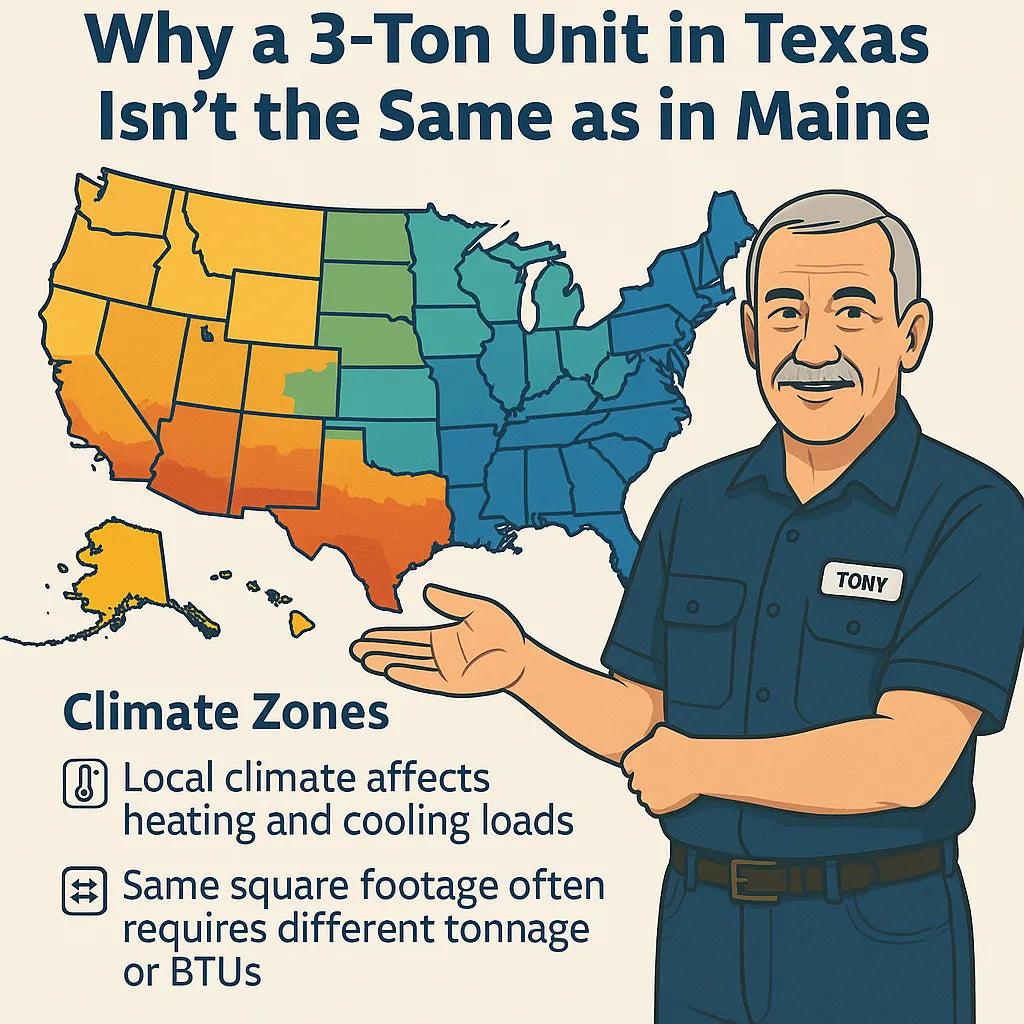When it comes to HVAC sizing, one number doesn’t fit all. A 3-ton system in Houston can cool up to 1,800 square feet—but the same system in Bangor, Maine, may be oversized and inefficient. That’s because climate zones have a huge impact on how much heating or cooling your home actually needs.
In this guide, we’ll explain how regional climate, humidity, and seasonal variation influence proper HVAC sizing—so homeowners like Tony can make smart, zone-specific decisions.
🧭 What Is a Climate Zone (and Why Does It Matter)?
The U.S. Department of Energy (DOE) divides the country into 8 climate zones based on:
-
Average temperatures
-
Heating Degree Days (HDD)
-
Cooling Degree Days (CDD)
-
Humidity levels
These zones are used by HVAC professionals to determine:
-
Heating and cooling loads
-
Duct design
-
Equipment selection
-
Energy code compliance
🔗 DOE Climate Zone Map (via PNNL)
🌡️ How Climate Zones Affect HVAC Load
HVAC systems are sized by load, not square footage alone. Load = how much energy it takes to maintain comfort in your space. And that varies dramatically between Texas and Maine.
| Zone | Example States | Key Traits | Typical BTU/Sq Ft |
|---|---|---|---|
| 1–2 | FL, TX | Hot, humid | 20–25 |
| 3–4 | NC, TN, NV | Mixed | 25–30 |
| 5–6 | IL, NY, PA | Cold | 30–40 |
| 7–8 | ME, ND, MN | Very Cold | 40–50+ |
🔍 A 3-ton system (36,000 BTUs) serves:
-
~1,800 sq ft in Texas (Zone 2)
-
~1,200 sq ft in Maine (Zone 7)
📊 Visual: Average BTUs per Sq Ft by Zone

This chart shows how climate zones shift your HVAC needs, even when your square footage stays the same.
🌀 Humidity’s Hidden Load
In hot-humid zones (like Texas, Florida, Georgia):
-
Air conditioning systems must also dehumidify
-
Systems that cool too quickly don’t remove enough moisture
-
Oversizing leads to sticky, clammy conditions
🔧 Solution: Proper sizing and longer cycles for better moisture control
🔗 ASHRAE Guide: Sensible vs. Latent Heat
❄️ Cold Climates Need High Heating Capacity
In cold-dry zones (like Minnesota or Maine), heating dominates. You’ll need:
-
Higher BTUs per sq ft
-
High AFUE gas furnaces or cold-climate heat pumps
-
Supplemental electric heat strips if using heat pumps
🔗 ENERGY STAR: Cold Climate Heat Pumps
🔁 Why a “One-Size” HVAC System Doesn’t Work
Let’s compare two homes:
-
Home A in Houston, TX (Zone 2)
-
1,600 sq ft
-
3-ton system works perfectly
-
Focus: high SEER2, good dehumidification
-
-
Home B in Bangor, ME (Zone 7)
-
1,600 sq ft
-
3-ton cooling is too much
-
60,000 BTU furnace or dual-fuel heat pump needed
-
Same size. Two totally different HVAC needs.
🧱 Other Key Sizing Factors (Besides Climate)
Even within the same zone, these impact load:
-
🧱 Insulation levels (walls, attic, crawlspace)
-
🪟 Window type and orientation
-
🌬️ Duct efficiency
-
🏠 Home layout (open concept vs. closed rooms)
-
📐 Ceiling height
🔗 Energy.gov: Insulation & Air Sealing Guide
📐 Use a Manual J to Size Precisely
Climate zone is just one piece of the puzzle. A full Manual J load calculation includes:
-
Orientation
-
R-values
-
Window U-factor & SHGC
-
Internal heat gain (appliances, people)
-
Local weather data (design day)
🔗 CoolCalc – Free Manual J Tool
🔗 ACCA Manual J Standards
🧠 Tony’s Real-World Sizing Advice by Region
| Region | Strategy |
|---|---|
| Southeast | Use 22–25 BTU/sq ft. Prioritize SEER2, moisture control. |
| Southwest | Use 25–28 BTU/sq ft. Focus on filtration + zoning. |
| Midwest | Use 30–35 BTU/sq ft. Balance SEER2 and AFUE efficiency. |
| Northeast | Use 35–40+ BTU/sq ft. Consider high-efficiency gas or dual fuel. |
| Mountain West | Use Manual J. Watch for elevation’s impact on performance. |
🧮 Example Comparison: 3-Ton System in Different Zones
| Location | Sq Ft Covered by 3-Ton Unit |
|---|---|
| Houston, TX | 1,800 sq ft |
| Charlotte, NC | 1,500 sq ft |
| Chicago, IL | 1,300 sq ft |
| Minneapolis, MN | 1,100–1,200 sq ft |
✅ Final Takeaway: Don’t Size Without Your Zone
Climate zone is the starting point of every proper HVAC decision. Without it, your system might:
-
Fail to control humidity
-
Waste energy
-
Deliver poor comfort in extreme weather
-
Lead to costly early replacements
For Tony—and every smart homeowner—the right HVAC system starts with knowing your climate zone, then using tools like Manual J and The Furnace Outlet’s Sizing Guide to make informed choices.
In the next topic we will know more about: Heat Pump vs. AC: Which One Sizes Differently (and Why It Matters for Tony)







